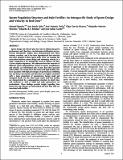Por favor, use este identificador para citar o enlazar a este item:
http://hdl.handle.net/10261/128784COMPARTIR / EXPORTAR:
 SHARE SHARE
 CORE
BASE CORE
BASE
|
|
| Visualizar otros formatos: MARC | Dublin Core | RDF | ORE | MODS | METS | DIDL | DATACITE | |

| Título: | Sperm population structure and male fertility: An intraspecific study of sperm design and velocity in Red Deer |
Autor: | Ramón, Manuel CSIC ORCID ; Soler, Ana J. CSIC ORCID; Ortiz, José Antonio; García-Álvarez, Olga CSIC ORCID; Maroto-Morales, Alejandro CSIC; Roldán, Eduardo R. S. CSIC ORCID ; Garde, José Julián CSIC ORCID | Palabras clave: | Sperm subpopulations Sperm velocity Sperm size Sperm length Ejaculate heterogeneity Fertility Sperm |
Fecha de publicación: | 7-nov-2013 | Editor: | Society for the Study of Reproduction | Citación: | Biology of Reproduction 89(5): Article 110 (2013) | Resumen: | Sperm design and velocity play key roles in influencing sperm performance and, therefore, can determine fertilization success. Several interspecific studies have demonstrated how these features correlate, and it has been hypothesized that selection may drive changes in these sperm traits. Here, we examine the association between sperm design and swimming velocity in a study conducted at an intraspecific level in Iberian red deer (Cervus elaphus hispanicus). We addressed how the structure of different sperm subpopulations, based on sperm morphometry and velocity, are interrelated and, in turn, how they associate with fertility. Our results show that males with high fertility rates have ejaculates with high percentages of spermatozoa exhibiting fast and linear movements and that these are highly correlated with a large proportion of spermatozoa having small and elongated heads. On the other hand, males with low fertility are characterized by a subpopulation structure in which slow and nonlinear as well as small and wide spermatozoa are predominant. These findings provide insight regarding how sperm size and velocity are interrelated and how they both are associated with fertility. © 2013 by the Society for the Study of Reproduction, Inc. | URI: | http://hdl.handle.net/10261/128784 | DOI: | 10.1095/biolreprod.113.112110 | Identificadores: | doi: 10.1095/biolreprod.113.112110 e-issn: 1529-7268 issn: 0006-3363 |
| Aparece en las colecciones: | (MNCN) Artículos |
Ficheros en este ítem:
| Fichero | Descripción | Tamaño | Formato | |
|---|---|---|---|---|
| BIOLOGY OF REPRODUCTION 89(5) 110, 1–7 (2013).pdf | 319,67 kB | Adobe PDF |  Visualizar/Abrir |
CORE Recommender
SCOPUSTM
Citations
50
checked on 12-abr-2024
WEB OF SCIENCETM
Citations
47
checked on 29-feb-2024
Page view(s)
261
checked on 18-abr-2024
Download(s)
265
checked on 18-abr-2024
Google ScholarTM
Check
Altmetric
Altmetric
Este item está licenciado bajo una Licencia Creative Commons

